 Shigeko Kubota: River (detail), 1979-81, silent color video, three monitors, stainless–steel container, mirrors, pump, water. Photo Peter Harris. Courtesy Shigeko Kubota Video Art Foundation, New York and MIT List Visual Arts Center, Cambridge, MA.
Shigeko Kubota: River (detail), 1979-81, silent color video, three monitors, stainless–steel container, mirrors, pump, water. Photo Peter Harris. Courtesy Shigeko Kubota Video Art Foundation, New York and MIT List Visual Arts Center, Cambridge, MA.  Poster for “Viva Video!: The Art and Life of Shigeko Kubota” at Niigata Prefectural Museum of Art; The National Museum of Art, Osaka; and the Museum of Contemporary Art, Tokyo.
Poster for “Viva Video!: The Art and Life of Shigeko Kubota” at Niigata Prefectural Museum of Art; The National Museum of Art, Osaka; and the Museum of Contemporary Art, Tokyo.
In 1965 and while in her mid-twenties, Shigeko Kubota performed her most famous work, Vagina Painting. Before a group of ten or so artists involved with the Fluxus movement in downtown New York, she tied a paintbrush dipped in red to her underwear so that it appeared to come from inside her, then dragged it around a canvas on the floor by moving her hips. The work, which lives on in photographs taken by Fluxus artist George Maciunas, has been praised by numerous feminist art historians in the decades since for radically subverting traditional, patriarchal roles: man as artist, woman as nude muse. Art historian Kristine Stiles described the work in 1993 as “the most aggressively proto-feminist performance of Fluxus” because it challenges the longstanding notion of women as passive objects when it comes to art. Others read it as a fierce rebuttal of Yves Klein’s “Anthropometry” works (begun 1960), for which he dipped women’s bodies in his signature shade of blue and dragged them across canvases, objectifying them literally.
Kubota never performed this sort of body art ever again, though. In fact, in an oral history interview done for MoMA’s C-MAP global research project shortly before her death in 2015, she recalled that she was “begged to do” the piece by two male artists—Maciunas and Nam June Paik, whom she later married. With this in mind, feminist interpretations of the piece become less convincing.
For the rest of her career, Kubota mainly worked in a different medium: video sculpture, with her focus largely on landscapes. She carved her own visual language for pondering the well-trodden genre of the sublime. Occasionally, she also devoted works to her art historical heroes—including her husband. These works remain less known than Vagina Painting, though that all may change with the artist’s upcoming survey at the Museum of Modern Art in New York, which opens August 21 and includes much of the long-neglected work she made in the decades that followed her famed 1965 performance. Meanwhile, a Kubota retrospective is traveling in Japan through February 2022, with a run in her hometown of Niigata before showings in Osaka and Tokyo.
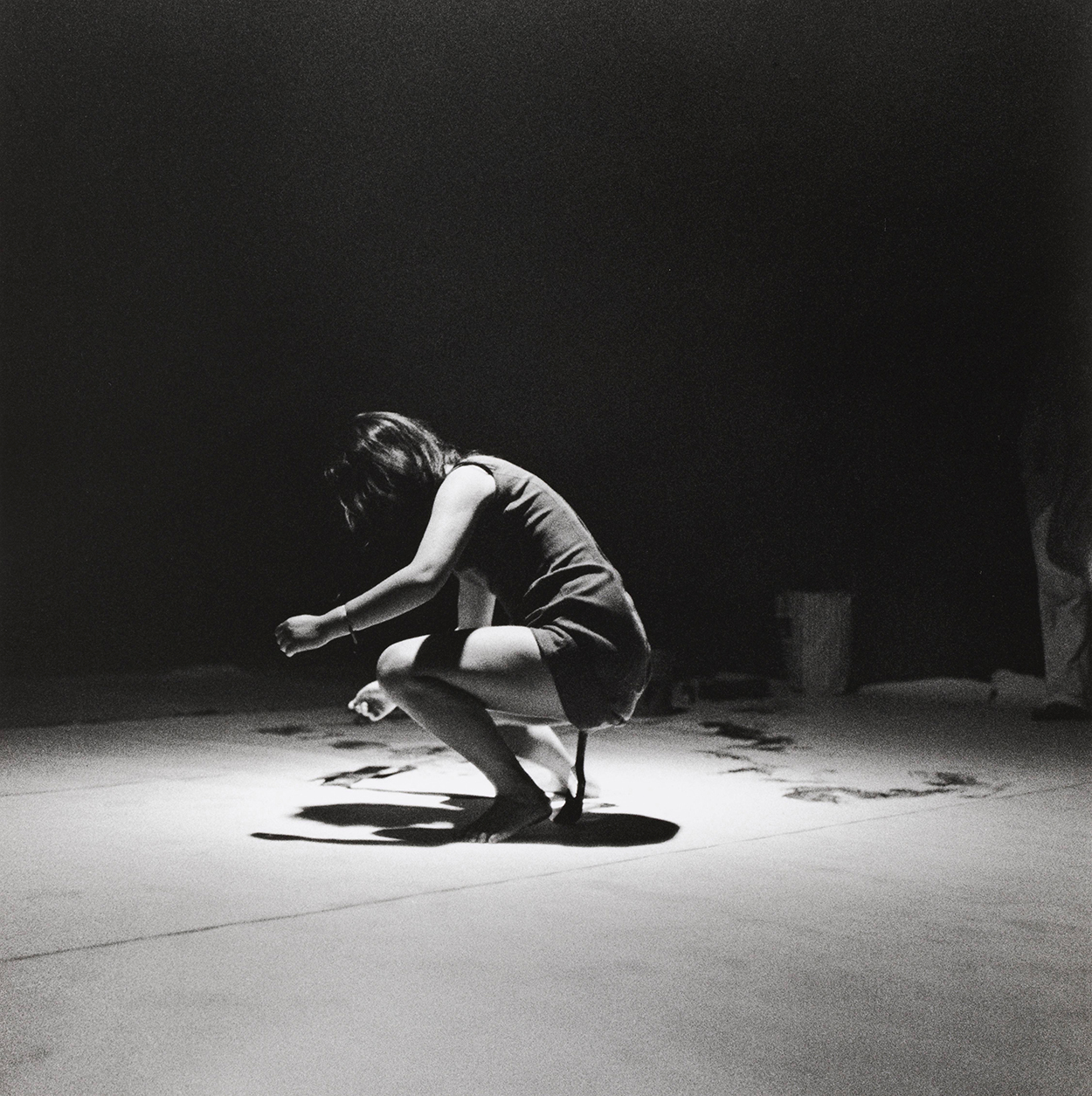 Shigeko Kubota: Vagina Painting, July 4, 1965. Photo George Maciunas. Courtesy the Museum of Modern Art, New York and the Shigeko Kubota Video Art Foundation, New York. © Artists Rights Society (ARS).
Shigeko Kubota: Vagina Painting, July 4, 1965. Photo George Maciunas. Courtesy the Museum of Modern Art, New York and the Shigeko Kubota Video Art Foundation, New York. © Artists Rights Society (ARS).
Kubota’s exhibition history has been scant until now. In 1978, she had a two-person show at the Whitney Museum of American Art with Takahiko Iimura, another Japanese-American video artist. In 1991, a survey of her work was displayed at the American Museum of the Moving Image in Queens. The catalogue for that show included some of her writing—sometimes, she’d display poems alongside her video sculptures—replete with the iconic line that sums up the arc of her career: “Video is vengeance of vagina.”
She was integral to the New York art scene of the latter half of the 20th century. From 1974–82, she worked as the video art curator at the Anthology Film Archives, and her Mercer street neighbors included Joan Jonas, Alison Knowles, and Donald Judd. From 1967–69, she was married to the experimental composer David Behrman, and in 1977, she wedded Paik. Maciunas, who helped formalize the Fluxus movement, foresaw her central role when he implored her to move to the United States. He subsequently named her vice president of the Fluxus movement upon her arrival. It was an acknowledgment of the administrative work she did for the avant-garde and anti-elitist movement. Maciunas’s letter arrived on the heels of the disappointing reception she received following her only show in Tokyo. At that point, as she wrote in 2007, she felt “that female artists could not become recognized in Japan.” Though arguably, her recognition in the US has been eclipsed by that of the men she supported.
The 1969 exhibition “TV as a Creative Medium,” put on in New York by Howard Wise at the gallery he ran before founding Electronic Arts Intermix (EAI), had a profound impact on Kubota. The show brought together early experiments, and helped prove to artists and critics that televisual technology could be used creatively before the medium was widely accepted as an artistic one. Kubota’s six-page review for the Japanese art magazine Bijutsu Techo helped spread the word about video art across the globe. The following year, while teaching at CalArts, she completed her first experiment in video—a glitchy, colorized, close-up self-portrait made using a synthesizer engineered by Paik and with Shuya Abe, a Japanese electrician, both of whom also led classes at the famed art school. A version of the footage was used in Video Poem (1970–75), where it was played on a monitor inside a nylon bag that was left unzipped, revealing her face onscreen. Video Poem was shown alongside memorable pieces by Bruce Nauman, Howardena Pindell, and Walter De Maria in “Rooms,” the show that inaugurated MoMA PS1 (then the P.S. 1 Contemporary Art Center) in 1976.
Kubota began making video sculptures like Video Poem in part because she wanted to complicate the idea that video art is “fragile, superficial, temporal, instant.” She thought hard about how the medium worked—and didn’t work—in the context of the white cube. Within a gallery space, she realized, video required presentation strategies that differed from those common in the more traditional black box. She hoped that by covering up monitors with other materials, she could help divorce them from their everyday connotations, which was important because, like many early video artists, she believed TV was often watched mindlessly.
Today, works like Kubota’s are more likely to be termed “video installations” rather than video sculptures. During her lifetime, Kubota raised concerns about the latter term. She was worried that “installation”—not yet an established piece of jargon in an art context—might be confused with the German word installateur, which means “plumber” (Germany was a major video art hub). Paik’s video sculptures are now better-known, but Kubota claimed she more or less came up with the genre. “In the beginning Paik only used the television set, just like that, bare without anything. Then I told him that a television by itself is not work,” she told an interviewer in 2008. “It could be found in any store he needed to add something. He didn’t listen to me, so I decided to do it myself.”
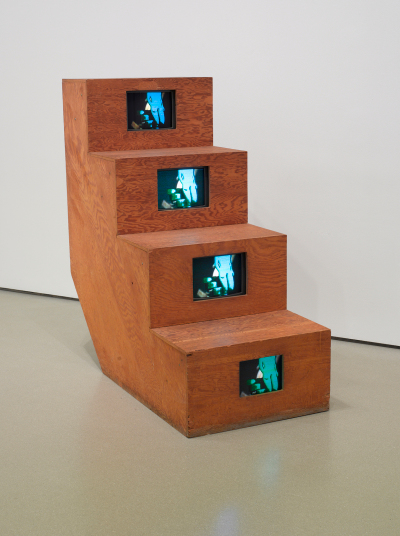 Shigeko Kubota: Duchampiana: Nude Descending a Staircase, 1976, video and Super 8mm film, four cathode-ray tube monitors, and plywood, 5 minutes 21 seconds, 66¼ by 31 by 67 inches. Photo John Wronn. Courtesy the Museum of Modern Art, New York. © Artists Rights Society (ARS).
Shigeko Kubota: Duchampiana: Nude Descending a Staircase, 1976, video and Super 8mm film, four cathode-ray tube monitors, and plywood, 5 minutes 21 seconds, 66¼ by 31 by 67 inches. Photo John Wronn. Courtesy the Museum of Modern Art, New York. © Artists Rights Society (ARS).
Kubota’s first major body of video sculptures was dedicated to the artist Marcel Duchamp. In 1968, the two artists met on a plane—both were traveling to Rochester for the opening night of Merce Cunningham’s Walkaround Time. Duchamp died that same year. Starstruck and mourning, Kubota began her “Duchampiana” series in 1972 with Duchampiana: Marcel Duchamp’s Grave (1972–75). In the work, footage of his tombstone—inscribed with the epitaph D’ailleurs, c’est toujours les autres qui meurent (Besides, it’s always the others who die)—is repeated across twelve nine-inch monitors. The tiny screens are stacked vertically in a plywood sheath, flanked by two mirrors that extend toward the viewer. Kubota’s obsession with death—perhaps influenced by her grandfather, a Buddhist monk who participated in many funerals—persisted throughout her career. In the catalogue for the MoMA exhibition, art historian Gloria Sutton posits that perhaps this obsession with futility drove her interest in glitchy video, as she wanted to highlight the medium’s impermanence.
In other “Duchampiana” works, Kubota borrows some of Duchamp’s famous compositions. In 1983, she stuck tiny monitors in the spokes of bicycle wheels turned upside down and perched on top of stools in reference to Duchamp’s assisted readymade Bicycle Wheel (1951). And, she reinterpreted his iconic painting Nude Descending a Staircase (1912) by lining a plywood staircase with four monitors, each showing footage she filmed of a nude woman traipsing down the stairs at Anthology Film Archives. It’s tempting to read this work as a feminist rejoinder to art history’s obsession with the female nude on the heels of Vagina Painting, but when Kubota spoke about Nude Descending during her lifetime, she focused on her earnest reverence for Duchamp—especially his interest in capturing movement over time, an ambition she saw ripe for updating via video. In 1981, Nude Descending a Staircase became the first video sculpture MoMA ever acquired.
From 1972–73, Kubota was part of a short-lived multiracial feminist video art collective called Red, White, Yellow, and Black. The name riffed on the colors of the American flag, and also referred to each member’s skin color. Kubota was joined by Mary Lucier, Celia Sandoval, and Charlotte Warren, and the group held two “multimedia concerts” at the Kitchen in New York. In December 1973, Kubota showed Riverrun—Video Water Poem, which introduced another recurring motif in her work—flowing water. Four channels showed rivers and canals she recorded while traveling in Europe, and a fifth played footage of the Hudson River. In front of the monitors, a fountain spewed orange soda, and on a sixth channel, there was live footage of viewers drinking form it. This was the only channel in color. Art historian Midori Yoshimoto claims that Riverrun was the “first of its kind” to combine multichannel video with other materials.
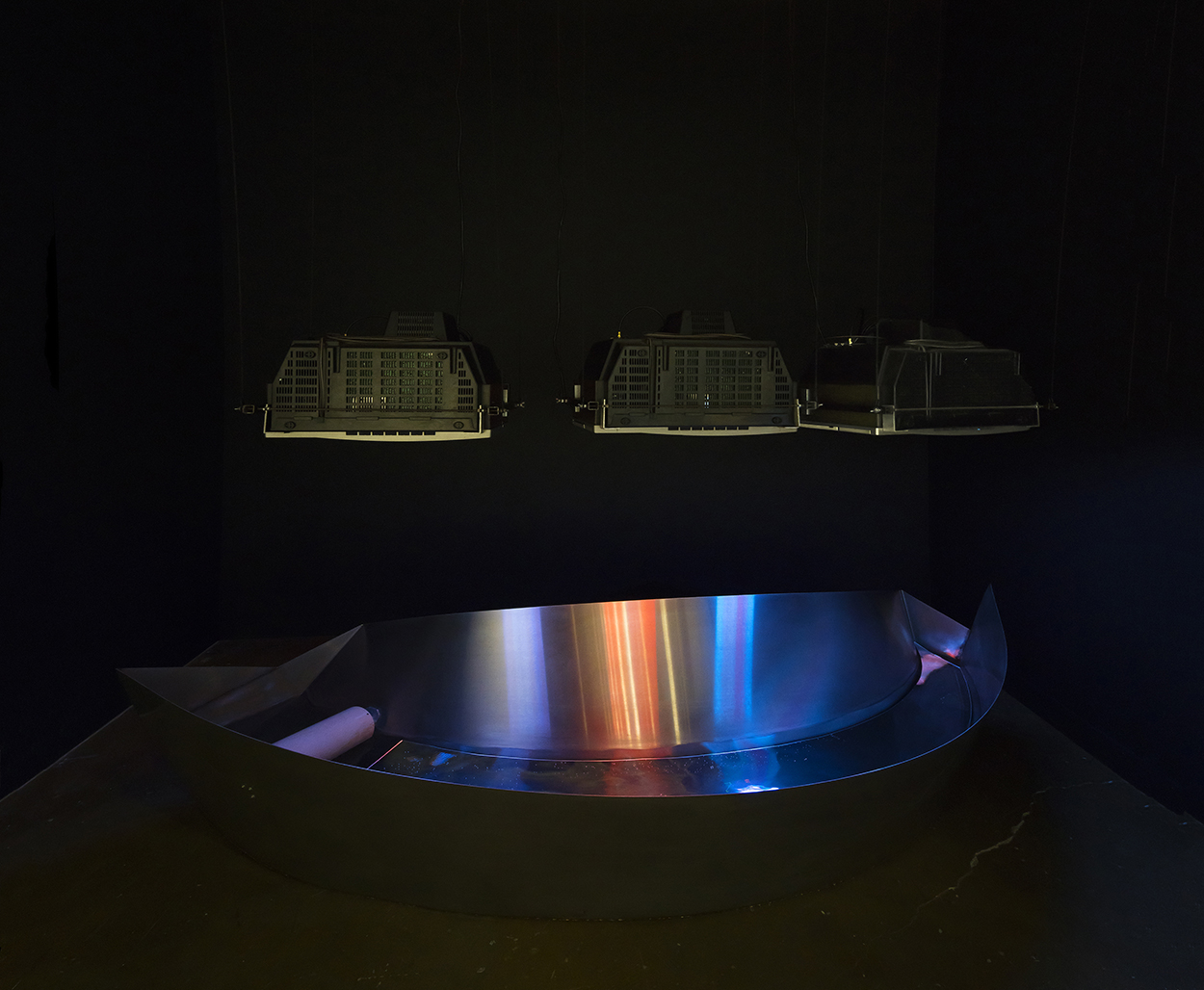 Shigeko Kubota: River, 1979-81, silent color video, three monitors, stainless-steel container, mirrors, pump, water. Photo Peter Harris. Courtesy Shigeko Kubota Video Art Foundation, New York and MIT List Visual Arts Center, Cambridge, MA.
Shigeko Kubota: River, 1979-81, silent color video, three monitors, stainless-steel container, mirrors, pump, water. Photo Peter Harris. Courtesy Shigeko Kubota Video Art Foundation, New York and MIT List Visual Arts Center, Cambridge, MA.
Kubota returned to water frequently in search of what she called “a total freedom to dissolve,” and several of her works express a desire to be subsumed by nature. Perhaps she was not fearful of technology—or at least not in the way that many of her early video art contemporaries were—because her Buddhist upbringing taught her to embrace impermanence. She also saw the closed circuit—an essential component of analog video—as synonymous with the way that rivers cycle water.
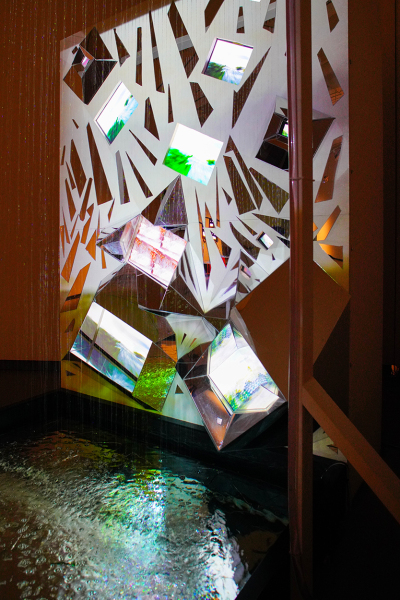 Shigeko Kubota: Niagara Falls, 1985, video sculpture. Courtesy Shigeko Kubota Video Art Foundation, New York.
Shigeko Kubota: Niagara Falls, 1985, video sculpture. Courtesy Shigeko Kubota Video Art Foundation, New York.
Standouts from this body of work include River (1979–81) and Niagara Falls (1985). In River, three monitors hang from the ceiling and face the floor, where the footage is then reflected by a metal trough filled with water, lined with broken mirrors, and replete with a small motor that creates waves. The brightly colored shapes and footage of the artist swimming becomes abstracted in the reflection, and the bouncing colors make the work something of a proto-projection. Niagara Falls (1985), meanwhile, is a matrix of small monitors and metal reflected in a rectangular pool of water. Kubota once said that the grand waterfalls made her feel liberated from herself. Rather than capturing their largeness with a wide shot, she recorded the falls up close, as if engulfed.
Even the storm that flooded Paik and Kubota’s loft and destroyed several important tapes only amplified her reverence for water. She commemorated the event in a video titled SoHo SoAp/Rain Damage (1985), which includes one of her signature poetic lines: “It rains on my heart, it rains on my video art.” (The loft—in a Jonas Mekas–owned building on Mercer Street—still houses the Shigeko Kubota Video Art Foundation.)
 Shigeko Kubota: SoHo SoAp/Rain Damage, 1985. video, 8 minutes 25 seconds. Courtesy the Museum of Modern Art, New York; Shigeko Kubota Video Art Foundation, New York; and Electronic Arts Intermix (EAI), New York.
Shigeko Kubota: SoHo SoAp/Rain Damage, 1985. video, 8 minutes 25 seconds. Courtesy the Museum of Modern Art, New York; Shigeko Kubota Video Art Foundation, New York; and Electronic Arts Intermix (EAI), New York.
Kubota devoted much of her time and energy to supporting Paik. She has said that he would spend the salary from her job at Anthology Film Archives on nothing but monitors, and joked that they had so little left over, they needed to sleep on a TV bed. In 1972, Paik literalized the idea in a work called TV Bed, which curators often frame as an homage to Charlotte Moorman. While this could be true, it’s also an example of how Paik and Moorman’s collaborations were much more visible than Paik’s and Kubota’s. Paik famously made a TV bra (in 1969) and, later, a TV cello (in 1971) for the famous “topless cellist.” Moorman’s choice to perform in the nude was more compatible with the maker/muse role that Paik sought, and was a way of working that Kubota refused. Moorman’s visibility, like the reception of Vagina Painting, confirms Lucy Lippard’s argument in a 1976 issue of A.i.A. that feminist body art—which often lives on in photographs by men—tended during the ’70s to be picked up more eagerly by the art world than did “neutral art by women that ignores the sexual identity of its maker.”
In 1996, Paik had a stroke that left him paralyzed on the left side, and Kubota began a decade-long pause from her own work to support him. She helped a debilitated Paik mount his monumental 2000 retrospective at the Guggenheim Museum in New York. The show solidified his reputation as the “father of video art,” making Kubota the medium’s underappreciated mother, in a sense. To complain that the work of a twentieth-century female artist was overshadowed by her husband’s is hardly surprising—a dangerous cliché even, as it can supersede discussion of the merit of that woman’s work—but that doesn’t make it any less sad.
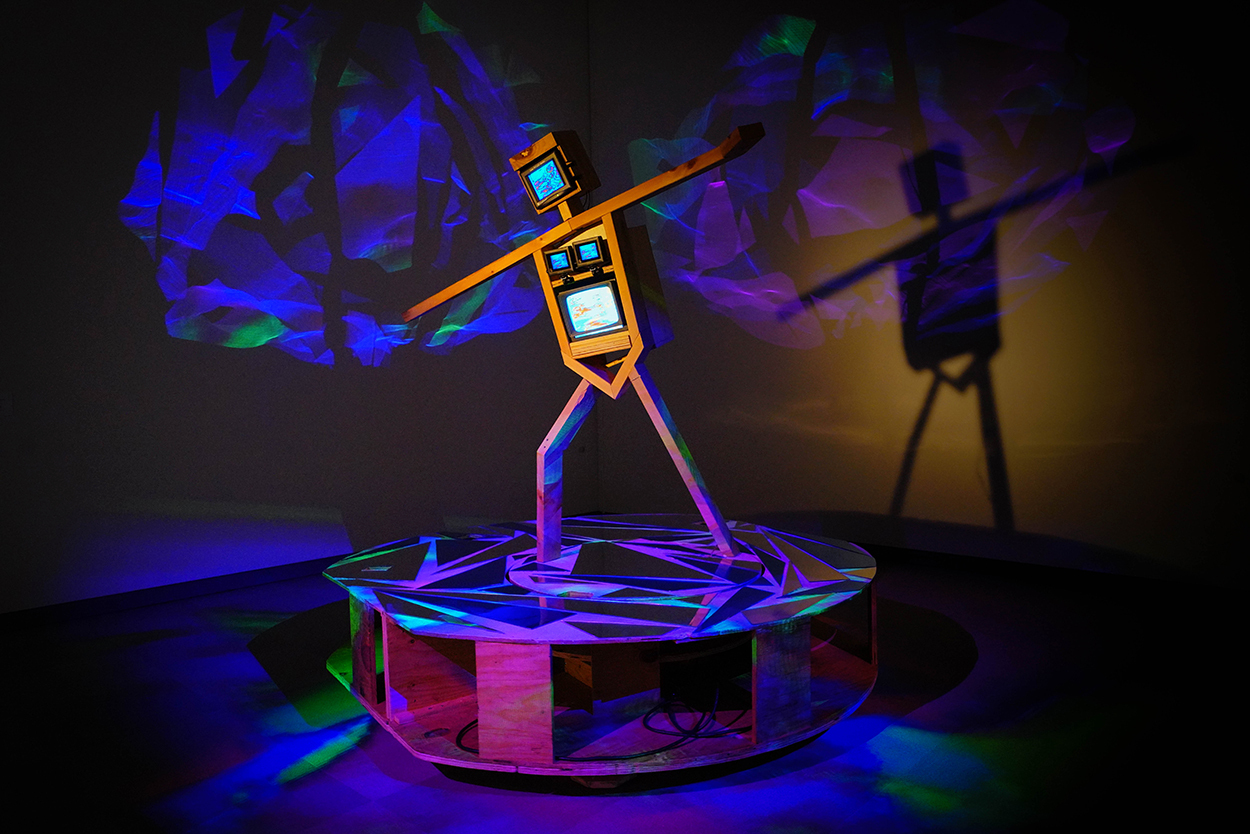 Shigeko Kubota: Skater, 1993, video sculpture. Photo Yukihiro Yoshihara. Courtesy Shigeko Kubota Video Art Foundation, New York.
Shigeko Kubota: Skater, 1993, video sculpture. Photo Yukihiro Yoshihara. Courtesy Shigeko Kubota Video Art Foundation, New York.
Kubota knew how people saw her vis-à-vis Paik. In 2007, a year after Paik died, she opened “My Life with Nam June Paik,” one of her few and final solo exhibitions, at Stendhal Gallery in New York. The show featured lighthearted sculptures depicting the couple in robot form displaying footage of their final years together, which they spent in Miami. In one, she’s jogging with dumbbells, and in another, Paik is peeing. She complained that a reporter covering the show asked her why she would use a rare platform—a moment of fleeting attention on her work—to advance Paik’s legacy rather than her own, as if the oversight of her work was somehow her fault, and as if caring for or missing her sick husband or considering him a muse was somehow anti-feminist.
Here again, video sculptures were a vehicle for mourning. At once ephemeral and monumental—or as Kubota put it, both hot and cold—it was the perfect medium for both remembering and letting go.
Source link : https://www.artnews.com/feature/shigeko-kubota-who-was-she-why-is-she-important-1234601001












